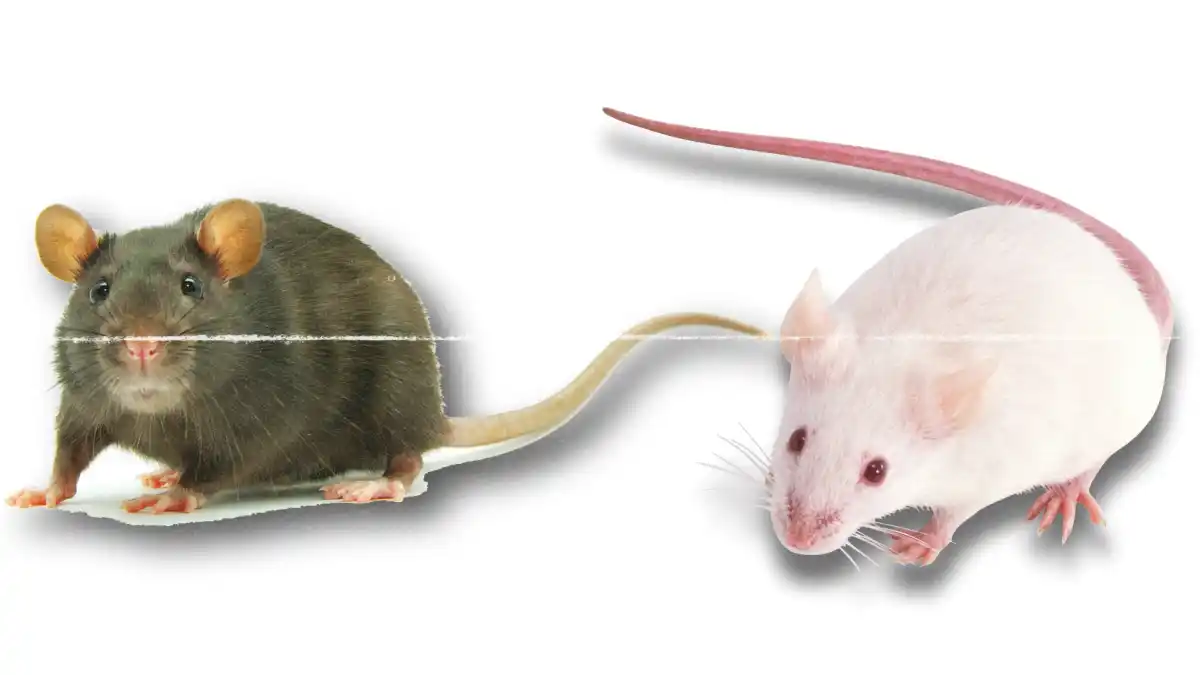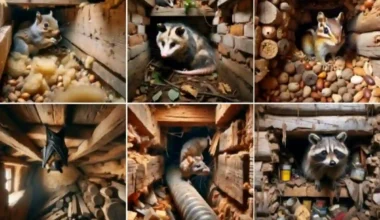Mice and rats are both unwanted pests in your home. But, if you unexpectedly come face to face with a furry rodent, how can you determine if it’s a mouse or a rat in your home? There are various methods to tell if you have mice or rats. One of the most frequent mistakes when trying to distinguish the type of rodent in a home is confusing a mature mouse for a young rat. But we will fix that in this article by giving you the top features to look for in both.
How to tell if you have mice or rats

Mice and rats may be similar but they have some different features about them. Below are ways to tell if you have mice or rats:
1. Physical appearance
Baby rats have heads and feet that are larger in proportion to their bodies and their faces are stubby with wide noses. They have an ungainly appearance, much like other young mammals, including humans. On the other hand, adult mice have bodies that are more proportional and slender, and their heads have a more sharply defined appearance.
Adult rats are generally larger than mice, with a length of around 16 inches and a heavier body mass, and often have darker fur. They also have a more rounded snout compared to mice and their fur may appear shiny due to its greasiness. On the other hand, mice can be identified by their smaller size, usually no larger than 8 inches, and larger ears. They also have a distinctively sharp snout and thinner tails compared to rats.
2. Dietary menu
If you have noticed missing or gnawed food, it can be a useful clue in determining which type of rodent has taken up residence in your home.
Mice tend to consume cereal grains such as wheat, rice, and barley, making pantries or dry goods storage areas in the kitchen particularly appealing to them. However, rats prefer soft and moist fruits and vegetables like bananas, avocados, tomatoes, and apples that can be stored without refrigeration. Rats also drink more water per day than mice, making pet water bowls potential areas of activity.
Both mice and rats are opportunistic feeders and will consume whatever food is available if their preferred options are not present.
3. Size and shape of droppings
Examining the droppings is a useful way to tell if you have mice or rats in your home. Although it may not be a pleasant task, it can simplify identification.
Rat droppings are typically black and glossy, measuring up to 1/2 – 3/4 of an inch long in length. Mouse droppings, on the other hand, are smaller, usually 1/4 inch long, and occur in larger quantities.
4. Rodent behavior
Mice tend to be more routine-oriented than rats. For instance, they usually eat in the same location repeatedly, while rats are more prone to scavenging.
Despite their larger size, rats are often more cautious than mice, only venturing out when they feel secure and unlikely to be seen. Mice, on the other hand, are more inquisitive and will readily explore new and unfamiliar items within their territory. This characteristic makes mice easier to trap, compared to rats.
5. Rats tend to cover their tracks
You may notice that some creature has been eating late-night snacks like cookies, bread, and chocolate. However, detecting a rat problem can be challenging in some situations.
Rats with a habit of nighttime snacking can often hide all evidence of their feast. In some instances, the only sign of a rodent infestation is a suspiciously damaged package of Ramen noodles, with no droppings or sightings to be found.
6. Size of scratches
Note also that the typical rat teeth marks are about 1/8-inch long, while smaller and “scratchier” marks usually indicate mice. So, if you detect these marks in the morning, you can now tell if you have mice or rats.
7. Food movement
Rats are more likely to move food to another place before consuming it. On the other hand, mice tend to consume small portions of food at the location where they find it.
This could be due to their larger size and ability to carry food like a granola bar, or simply a personal preference. Regardless, rats have a reputation for relocating food to a private area before eating it.
8. Droppings on the travel route
Droppings along the way are a tell-tale sign of the presence of mice. These droppings are typically small, with a shape resembling a grain of rice and pointed ends. You can find them in areas where mice frequent and feed, such as behind a stove, in the pantry, or under cabinetry.
Apart from droppings, mouse urine is also essential for communication. It serves as a means to attract potential mates or warn other male mice to stay away.
Therefore, if you find droppings away from the nest, you could be dealing with mice infestation.
9. Mice won’t grow to rat size
It may come as a surprise, but not everyone is aware that rats and mice belong to distinct species.
Rats are generally larger, heavier, and longer than mice, and their fecal droppings are also larger in size. While an adult mouse has a body length of 3 to 4 inches and a tail length of 3 to 4 inches, an adult rat can grow up to 9 to 11 inches in body length with a tail length of 7 to 9 inches.
How fast do rats and mice reproduce?
A female mouse can have a substantial impact on the population in her short lifespan of 1.5 to 2.5 years, as she can give birth to over 300 offspring. These offspring can start mating at a young age of just 4 weeks. As a result, a small number of mice can quickly produce a large population.
However, rats surpass mice in reproductive capabilities. In a single year, a pair of rats can generate as many as 2,000 offspring.
Why are rodents a problem?
Rodents are considered commensal animals, which means they have grown to depend, at least partially, on humans as a source of food. This is the reason they are commonly found living near homes in both urban and rural areas.
As the weather becomes colder, rodents start searching for indoor shelters to spend the winter. Homeowners should take measures to prevent this, as the presence of these pests can bring about numerous dangers. Rats and mice can cause harm to the structure of the home by gnawing on wires, pipes, insulation, and drywall.
In addition to damaging the structure of your home, rats, and mice can also harm personal belongings such as furniture, clothing, carpets, and storage containers. They can also contaminate food and food preparation areas, bringing diseases such as Salmonellosis, Hantavirus, Leptospirosis, and lymphocytic diseases. Additionally, they can establish nesting sites in hidden places like behind walls, in attics, basements, and even behind appliances.
Rodents have a fast reproductive rate, with two individuals quickly becoming 20 or more in a short time. Female mice have a gestation period of 21 days and typically have litters of six pups. These pups reach breeding age in just 6 weeks and each female can have up to 8 litters per year. This means that if a small rodent issue is not addressed promptly, it can quickly escalate into a larger problem. Rats have similar reproductive rates, with larger litters and a slightly longer pregnancy.
Whatever their numbers, expect an infestation if you do nothing about getting rid of or expelling them from your home.
Tips to prevent rodent infestation
After identifying the presence of rodents in your home and determining the specific type of invader, the next step is to get rid of them.
1. Keep rodents at bay
Seal cracks in your home’s foundation and secure doors and windows to prevent rodents from entering your space. Both rats and mice are capable of fitting through small openings, so blocked entry points keep them out.
2. Set humane traps
Effective baits and traps can be a highly successful way of eliminating mice and rats in your home. Don’t hesitate to seek the advice of a professional to determine the best type of traps for your needs and to ensure they are placed in optimal locations within your house.
3. Keep your home clean
A clean home may not eliminate mice and rats that have already infiltrated your space, but it can significantly reduce the likelihood of attracting them in the first place.
Ensure that garbage is disposed of regularly and food is stored properly and securely to prevent attracting rodents.
4. Get a pet security
Many cats and dogs have an innate love of chasing rodents, making it difficult for them to scavenge for food or breed effectively. Furthermore, the presence of a large predator, in the eyes of rodents, can serve as a powerful deterrent and keep them away from your home. That way, you don’t have to learn to tell if you have mice or rats.
Read also: busted the number of rats in your home






